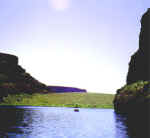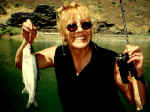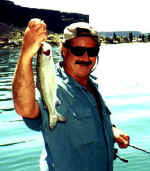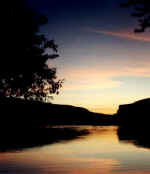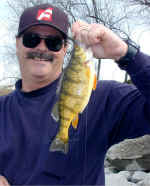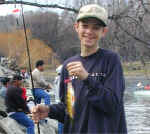Search
Latest Articles
Moses and Blue Lakes
by Dave Graybill, March 27, 2002
Before I share that experience with you though, I have got to tell you about this past weekend, and the fun Eileen and I had fishing for perch at Moses Lake. I was going to go somewhere else and try for some other kind of finny creature, but I got caught up in my brothers enthusiasm.
He had taken a whole gang of family members—uncles, cousins, nephews, etc.--to Moses Lake on Saturday, and although I couldn’t join them, I did get to partake in the fish feed that followed. The stories I heard around the dining table convinced me that I had better get in on this action before it went away for the season. So Eileen and I headed to Moses Lake on Sunday morning, looking to meet up with my brother and his buddies.
Sure enough, there they were, on the riprap on the shore along the I-90 Bridge. They had arrived about an hour or so before us, and we could see why. The secret was out. Almost every rock was taken, and at one time we counted 21 boats anchored just beyond casting distance from the shore.
Eileen and I scrambled down to the water next to my brother and joined the fishing party. We had a ball. We had just as much fun watching my brother, my cousin Greg Preston from Seattle, and another long-time fishing partner Kirk Bromley reel in fish after fish.

To give you an idea of just how many perch were gathered in this particular fishing ground, there were many occasions when fish were being landed that were hooked in the side or tail. When you set the hook and missed the bite of one perch, you often snagged another that was nearby. What appeared to be bites as your bait settled to the bottom was actually perch hitting your line!
Rick had advised bringing long rods to help hook the fish, that were in about 30 feet of water, maybe 50 feet offshore, and they really helped. We were using 9 ½-footers, and Rick’s gang was using rods up to 10 ½ feet. These really made a difference when you were trying to set a hook with that much line in the water.
Boaters had it easy of course. They could just anchor over the schools and get away with even ultra light tackle. The predominant bait was worms or crawlers and using a jig was really unnecessary. Due to the depth of the water, a bobber wasn’t very effective. People could catch fish using them, but it was obvious that the fish were on or near bottom. Eileen had here best luck when she cast out, let the sinkers hit bottom, and then retrieved her line till she felt a bite. Fortunately, there are few snags off the shore here, and this worked fine.
The quantity of the fishing here on Moses Lake is not the only attraction. The quality of the fish here is a real draw, too. The average perch caught here is about an inch bigger than the average on the Winchester Wasteway. We caught many that were 11 inches. I caught one that was at lease 12 inches, and an angler near me caught one that made it look small! The fishing is just as fast or faster than the Wasteway

Right now, and most anglers agreed that it would hold up for another couple of weeks. There’s still time to pack up the family and head over here for a great weekend of fishing fun, not to mention some mighty fine dining on perch fillets.
Well, enough about perch fishing. Let’s get to Blue Lake, and why it would be a great choice for spring trout fishing.

I’ll admit that I had fished Blue Lake once before, but it was so long ago I think I was still in college. That makes it ancient history. Very ancient. I didn’t know what to expect, but I had some good reasons to give it a try.
You see in the Fall of 1999, the state "rehabed" Blue Lake (and Park by the way, but you’ll hear about it later), and then restocked it with 200,000 catchable-size rainbow, and with 10,000 brown trout. If that doesn’t make an angler’s mouth water for opening day, what does!
The opener was a dandy in April of 2000, and of course plenty of anglers took advantage of the huge population of trout that were available. Catch rates were some of the highest anywhere in the state, and all anglers had to do was pull up to the guard rails along the highway and cast away.
When my native guide (Eileen) and I finished with smallmouth fishing on Banks Lake in late May of 2001, we headed the Smoker Craft in the direction of Blue Lake. I was not really expecting the kind of action that the first opening day following rehab offered anglers, but I did anticipate fairly decent fishing for fair-sized rainbow and maybe brown trout. I should mention here that Blue Lake received 24,000 fresh rainbow this season. The rainbow were 8 to 12 inches and were planted in March. There will be lots of hungry trout waiting for anglers on the opener, including a better than average number of holdover rainbow and brown trout that will be at least 18 inches.
We weren’t disappointed.
We started our morning at the south end, and finding a large, shallow flat, I decided to find a break line, where the water got deep fairly quickly, and that’s where I figured we would find some hungry trout. We didn’t have to travel far, maybe five hundred yards from the launch when we discovered water that dropped from about nine feet to a depth of just over 20 feet. That’s when I put out the gear.
I am a real fan of Rapalas, and since it was a very bright day, I opted for the Fire Tiger color in the floating model. These will dive to about ten feet when trolled at a clip that gives the rod tip a pretty good buzz, and I use the rod tip as my guide to adjust my speed to what the trout seem to want. (A tolling speed indicator is a much better way to keep track of trolling speed, but I haven’t got one mounted on the new Smoker Craft Millentia yet.)
Sure enough, bang-o. A nice rainbow hit the Rapala. That didn’t take long, but I wanted to see it we could tempt a brown trout from this same area of the lake. Not knowing exactly why I decided that maybe I should run something deeper for a big brown. We observed a couple of other boats trolling in our vicinity without any success, and a whole flotilla of boats anchored in what we termed "Power Bait Cove." There was very little activity from these quarters either.
I dug through the tackle box and put together what I thought would be the answer: a drop-lead rig with a two-once sinker, followed by 18 inches of leader with a Kokanee Dodger attached, and then another 15 inches of leader to a Wee Tad. The Wee Tad was the black-back, silver-bellied color.
I ran this rig out about 25, foot-long pulls behind the boat in about 20 feet of water and put the rod in the holder. We made maybe three runs along the break line before my rod folded over with a savage strike, and what do yea know! It was a nice, 19-inch brown. Quite a bit bigger than the rainbow we had boated earlier. But on the next turn I ignored my depth finder too long and hung up on the bottom. Lost the whole shootin’ match. Dang.
I thought, what the heck, lets see more of Blue Lake, and started to troll up toward the top end. Just looking for fish and checking depths. I want to warn anglers about the lakes in this region right here. You have got to keep a close look out over the bow. We were fortunate enough to have a flat, calm day, and reading the water ahead was easy. Basalt ridges, haystacks and shelves will run out from shore surprising distances, and sometimes appear without any warning, such as a sloping shoreline. Be ready to hit reverse in a hurry and I advise caution when seeking out break lines or a drop off. Proceed with care until familiar with the water you’re fishing. These conditions are common on all of the lakes that run from Banks Lake on down to Evergreen Reservoir, which all seem to be part of the same series of coulees that run for miles and miles down this valley. I had plenty of experience at hitting reverse when Eileen would spot one of these basalt prop chewers from the bow.
We dodged several of these shallow ledges, shelves, and sunken islands as we made our way up the east shore (opposite the highway) of Blue Lake. I found that the lake dropped off suddenly from these shelves to about 40 or more feet of water, but marked few fish the whole way up lake. Much of the shoreline here is occupied with year-round residences or summer homes, and there wasn’t any activity on my screen or on the water for that matter in this area of the lake.
At the top end of the lake, there is a large bay to the east, and although scenic and "fishy" looking I didn’t mark more than a few singles in my circuit through it. There was one boat anchored here, but the two anglers lolling inside it weren’t doing much, other than enjoying a nice sunny day.
We putted out of the bay, and carefully made our way back down lake and to the west until we were just below the resort that sits at the top end of the lake. We left the deeper water here and ventured near the highway shoreline. It was littered with sunken rock, but full of fish. Here’s where we hit pay dirt. At almost high noon!
We immediately began to hook fish on either the Fire Tiger or bright orange color of Rapala. The lures were the floating kind again, and a number seven size. We started in only five to seven feet of water. It was too nerve wracking, dodging the rocks, so I started trolling a line just off of them in nine to 12 twelve feet of water, and on a path that avoided some large sunken haystacks at the bottom end of the run. This way I could spend some time watching my rod and help Eileen release fish, too.

We caught fish running both up and down this line. What a ball! They weren’t huge. Mostly 12 to 13 inches, but on our light tackle a lot of fun. We could have spent the day there, but it was well over 90 degrees, and we needed a break.
We left this hot spot wondering what made it so? We had talked to the resort owner, and he had mentioned that the water had just warmed enough that the fish were starting to feed on some good hatches of insects. My guess is that this boulder field was a real hatching ground and had attracted a lot of fish. There was obviously a bunch of rainbow (no browns) gathered here, and the sight of our bright wriggling lures was just too much for them. They had to attack.
It made me wonder if the flat we ignored when we started the day may have been where we should have been fishing all the time. We made out way down lake to check it out, and found it to be nearly devoid of fish. We putted over to "Power Bait Bay" to check out the depth there, and discovered why so many anglers had been hanging out here earlier. There were fish here, too. Lots of them. All favoring the nine to 12 foot water. We hadn’t seen any fish taken here in the morning, but in mid-afternoon they were eager. It should reinforced the need to explore any new water, and not necessarily give up on water that seemed to be unproductive.

We were pretty much worn out by now, given the heat, so we packed it in. Not without a bit of reluctance, though. Blue Lake had shown us some pretty good fishing, but we had other plans for the evening bite. I’ll tell you about that later.
If you’d like to give Blue Lake a try, here’s how you’ll find it. Take I-90 from either Spokane or Seattle, and head for Ephrata. Head north through town on Highway 17, pass by Soap Lake, Lake Lenore and Alkali Lake. Just north of Alkali Lake, you’ll come upon Blue Lake Resort, and the bottom end of Blue Lake. Setting up a tent here costs $16.00, and includes showers, a launch, and friendly people. You can call ahead to reserve a space by calling (509)632-5364. Coulee Resort is at the north end of Blue Lake, with many of the same facilities on a smaller scale, and you can contact them by calling (509)632-5565.
There is also a Department of Fish and Wildlife launch on the east shore about midway up the lake.
As I mentioned earlier, there is quite a community of homes, many of them for summer use only, on Blue Lake, and you can expect a good number of water and jet skiers on the lake when summer heats up.
Early and late season anglers get the use of lake to their almost exclusive use when the weather and water is chilly, and this is the time to plan a trip to Blue Lake. Boats are available for rent at Blue Lake Resort for sure, but the shore fishing here is very good actually.
When you do get a chance to try Blue Lake, I hope you have as good an experience as Eileen and I did. We were both impressed with the aerobatics of Blue Lake rainbow. A couple of times I was alerted to a strike by the leaping of fish behind the boat! A 20 fish day is nothing special. It took a little exploring, but once the fish are found, trout fishing at Blue Lake is a piece of cake.

I hope this gets you excited about the upcoming season opener. I know I can’t wait to get at the many trout lakes in North Central Washington that offer this kind of action. I can’t wait to get back to Blue Lake this year.
In my next report, I will share with you what evening fly-fishing can be like at Park Lake, another lake in this popular chain of lakes that lie south of Banks Lake.
When you’re on my site this week, check out the Members Benefits Page. You’ll see the beginning of what will be a growing list of businesses that offer discounts to members of the FishingMagician.COM Club. These are all things that you can use when you travel to North Central Washington, and you’ll see how you can save you annual membership fee many times over!
Great information that can you use to make your fishing experiences the best possible, and money saving discounts. That’s what the FishingMagician.Com Club is all about!
